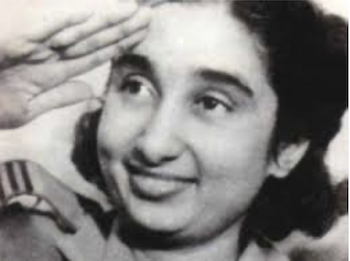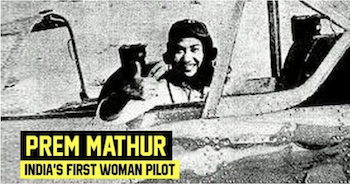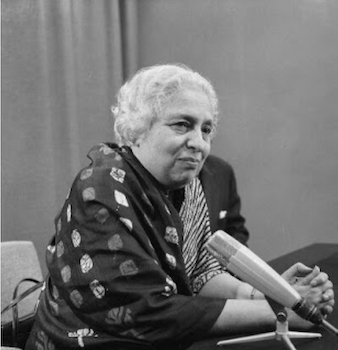
Prem Mathur was born on January 17, 1910, in Aligarh, Uttar Pradesh, India. When Mathur was about six months old, her mother passed away, leaving behind Mathur, her father, and four other siblings. Not much information is known about her parents and family or marital status and later family life, but it is known that her family moved to Allahabad due to her father’s transfer, with Allahabad being the city that Mathur was raised in. This city was the birthplace of Mathur’s dreams and road to success. Mathur attended Annie Besant School and Ewing Christian College (for her secondary education), later attending Allahabad University to obtain her bachelor’s degree. However, the most essential education and training that she received was not from her schooling, but rather Captain Atal, a pilot at Delhi Flying Club.
Within her family, some of Mathur’s siblings were influenced by the airline industry, with Mathur’s elder brother being a flight instructor, and her younger brother being a businessman, who partook in deals in relation to planes. In addition, especially later in her career, Mathur’s father was very vocal in his support for his daughter and even encouraged her to chase after her dreams and break the suffocating norms that were seen within the aviation industry. As a result, for years, Mathur had been surrounded by planes. When he purchased an old aircraft, Mathur’s younger brother hired Captain Atal of the Delhi Flying Club to fly his planes. Specifically, it was Captain Atal who took Mathur on her first flight, and attempted to scare her, in which he failed to. This catalyzed the sparks of desire of piloting to ignite for Mathur. With this, Atal allowed Mathur to practice her flying, and instructed her to truly pilot. As time went on, Atal became impressed by Mathur’s resilience despite the tenacity of piloting and suggested that “she is a tough woman” and that Mathur “can be a pilot.” Therefore, this motivated her to continue training and seek out the opportunity to pilot.

As she began to seek a chance to jumpstart her piloting career, the Allahabad Flying Club, a branch of the Lucknow Flying Club, one of multiple non-profit organizations for affordable aircraft access, opened up, with Captain Atal being a lead instructor of the new project. With this, Mathur became Captain Atal’s first student and practiced constantly, making great strides in her training, leading her to quickly fly solo and move forth with her career. However, this proved to not be easy. Mathur’s club, the Allahabad Club, was invited to compete in the National Air Race in Calcutta in the year 1949. Despite being as talented as her male counterparts, Mathur was discouraged from competing because of her gender and the fact that there were no other women competing in the air race. Regardless of what others had to say, Mathur won the 1949 National Air Race despite all the obstacles that she faced and all the backlash she received from competing. With this accomplishment, she proved that even though she had less experience than the other pilots and that she was a woman, so therefore “less qualified”, she was not held back from achieving her goals, and thrived greatly.
After the National Air Race, Mathur did not slow down. In fact, she continued to speed up in her motivation to gain her piloting license. Mathur started her lessons to earn her piloting license and excelled in her training. Subsequently, Mathur passed her license test with flying colors. However, despite all her success, rather than being offered a piloting position, she was given an instructor position with the statement that “although she could be a pilot, men are uncomfortable with a woman flying them around.” This gendered bias continued to halt her career, eventually causing eight different airlines to reject her from being a pilot with the belief that “men would not be comfortable with a female pilot.” Finally, on her ninth try, Mathur got a co-piloting offer at Deccan Airways. However, with this co-pilot position came no pay for Mathur for about six months due to the fact that Deccan Airways believed that, as a woman, men did not trust her to fly them as a solo pilot so she did not deserve the pay that her male counterparts earned. Despite this, during her time at Deccan Airways, she flew many important officials of India, such as Indira Gandhi and Lal Bahadur Shastri. She was responsible for being their pilot and excelled at this position countless times.

In spite of all of her experience, Deccan Airways refused to promote Mathur, maintaining the same belief that countless other airlines had: if a woman were to fly a plane, no one would get on it. She finally resigned from Deccan Airways after years of working for them, with the disappointment of not rising in position despite gaining so much experience. However, she was not left without a job. While in her co-pilot position, she impressed G.D. Birla, an Indian businessman, and was hired to be his private pilot. Then, she later joined Indian Airlines as a pilot, making her the first commercial female pilot in India. Mathur continued on with her piloting until she retired in 1984, later passing away from an unknown cause on December 22, 1992.
With all of these accomplishments, Mathur continued to be a well-known name in the airline industry, highlighting her resilience, courage, and determination in not taking no for an answer because she knew her own strengths. She paved the way for women to have a major role in jobs regarding the airline industry and broke through the glass ceiling, despite rejections due to her gender. Overall, Captain Mathur challenged the notion that women are equal in engaging intellectual pursuits, and are not inferior to men just by being women.
Why Did I Choose to Research Captain Prem Mathur?
I chose to research Captain Prem Mathur because she was the catalyst for women being the central roles in many parts of the aviation industry, from being flight attendants to piloting positions. She ignored the bias that many people showed against her because of her gender, and she was resilient and fought for her dream despite how many obstacles she encountered. Although she was considered less trained in comparison to her male counterparts, she showed that being a woman gives her strength and that women are no less worthy than a man for a position because of their gender.
Works Cited
Adil, Yashfeen. “Captain Prem Mathur: The Woman Who Swore to Fly High: #indianwomeninhistory.” Feminism in India, 11 Dec. 2019, http://feminisminindia.com/2019/09/05/captain-prem-mathur-the-woman-who-swore-to-fly-highindianwomeninhistory/
Pande, Pranjal. “The Story of Prem Mathur: India’s First Female Commercial Pilot.” Simple Flying, 24 Jan. 2022, http://simpleflying.com/prem-mathur/
“Meet Captain Prem Mathur, Indias First Female Commercial Pilot.” Zee News, http://zeenews.india.com/aviation/meet-captain-prem-mathur-indias-first-female-commercial-pilot-2433156.html
“Prem Mathur.” Women’s Activism NYC, http://www.womensactivism.nyc/stories/6665#:~:text=Prem%20Mathur%20was%20born%20on,was%20barely%20six%20months%20old
This article was published on 8/28/24